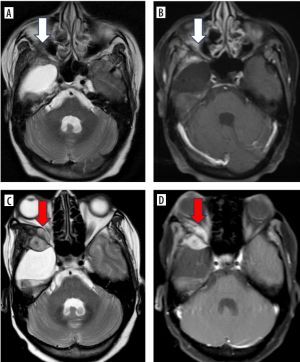NEURORADIOLOGY / ORIGINAL PAPER
External validation of the Brain Tumour Reporting and Data System (BT-RADS) in the multidisciplinary management of post-treatment gliomas
1
Tata Memorial Centre, Homi Bhabha National Institute, Mumbai, India
2
The Clatterbridge Cancer Centre, University of Liverpool, Liverpool, United Kingdom
These authors had equal contribution to this work
Submission date: 2023-10-22
Final revision date: 2023-12-18
Acceptance date: 2024-01-26
Publication date: 2024-03-15
Pol J Radiol, 2024; 89: 148-155
KEYWORDS
NeuroradiologyPost treatment gliomaBTRADSStructured reportingExternal validationpost-treatment gliomaBT-RADSstructured reportingneuroradiologyexternal validation
TOPICS
ABSTRACT
Introduction:
To independently and externally validate the Brain Tumour Reporting and Data System (BT-RADS) for post-treatment gliomas and assess interobserver variability.
Material and methods:
In this retrospective observational study, consecutive MRIs of 100 post-treatment glioma patients were reviewed by two independent radiologists (RD1 and RD2) and assigned a BT-RADS score. Inter-observer agreement statistics were determined by kappa statistics. The BT-RADS-linked management recommendations per score were compared with the multidisciplinary meeting (MDM) decisions.
Results:
The overall agreement rate between RD1 and RD2 was 62.7% (κ = 0.67). The agreement rate between RD1 and consensus was 83.3% (κ = 0.85), while the agreement between RD2 and consensus was 69.3% (κ = 0.79). Among the radiologists, agreement was highest for score 2 and lowest for score 3b. There was a 97.9% agreement between BT-RADS-linked management recommendations and MDM decisions.
Conclusions:
BT-RADS scoring led to improved consistency, and standardised language in the structured MRI reporting of post-treatment brain tumours. It demonstrated good overall agreement among the reporting radiologists at both extremes; however, variation rates increased in the middle part of the spectrum. The interpretation categories linked to management decisions showed a near-perfect match with MDM decisions.
To independently and externally validate the Brain Tumour Reporting and Data System (BT-RADS) for post-treatment gliomas and assess interobserver variability.
Material and methods:
In this retrospective observational study, consecutive MRIs of 100 post-treatment glioma patients were reviewed by two independent radiologists (RD1 and RD2) and assigned a BT-RADS score. Inter-observer agreement statistics were determined by kappa statistics. The BT-RADS-linked management recommendations per score were compared with the multidisciplinary meeting (MDM) decisions.
Results:
The overall agreement rate between RD1 and RD2 was 62.7% (κ = 0.67). The agreement rate between RD1 and consensus was 83.3% (κ = 0.85), while the agreement between RD2 and consensus was 69.3% (κ = 0.79). Among the radiologists, agreement was highest for score 2 and lowest for score 3b. There was a 97.9% agreement between BT-RADS-linked management recommendations and MDM decisions.
Conclusions:
BT-RADS scoring led to improved consistency, and standardised language in the structured MRI reporting of post-treatment brain tumours. It demonstrated good overall agreement among the reporting radiologists at both extremes; however, variation rates increased in the middle part of the spectrum. The interpretation categories linked to management decisions showed a near-perfect match with MDM decisions.
REFERENCES (13)
1.
Claus EB, Walsh KM, Wiencke JK, et al. Survival and low-grade glioma: the emergence of genetic information. Neurosurg Focus 2015; 38: E6. doi: 10.3171/2014.10.FOCUS12367.
2.
Crooms RC, Goldstein NE, Diamond EL, et al. Palliative care in high-grade glioma: a review. Brain Sci 2020; 10: 723. doi: 10.3390/brainsci10100723.
3.
Smits M, van den Bent MJ. Imaging correlates of adult glioma genotypes. Radiology 2017; 284: 316-331.
4.
Sahu A, Patnam NG, Goda JS, et al. Multiparametric magnetic resonance imaging correlates of isocitrate dehydrogenase mutation in WHO high-grade astrocytomas. J Pers Med 2022; 13: 72. doi: 10.3390/jpm13010072.
5.
Kessler AT, Bhatt AA. Brain tumour post-treatment imaging and treatment-related complications. Insights into Imaging 2018; 9: 1057-1075.
6.
Macdonald DR, Cascino TL, Schold SC Jr, et al. Response criteria for phase II studies of supratentorial malignant glioma. J Clin Oncol 1990; 8: 1277-1280.
7.
Tensaouti F, Khalifa J, Lusque A, et al. Response assessment in neuro-oncology criteria, contrast enhancement and perfusion MRI for assessing progression in glioblastoma. Neuroradiology 2017; 59: 1013-1020.
8.
Weinberg BD, Gore A, Shu HKG, et al. Management-based structured reporting of posttreatment glioma response with the brain tumor reporting and data system. J Am Coll Radiol 2018; 15: 767-771.
9.
Landis JR, Koch GG. The measurement of observer agreement for categorical data. Biometrics 1977: 159-174.
10.
Cooper M, Hoch M, Abidi S, et al. NIMG-10. Brain tumor MRI structured reporting allows calculation of interrater agreement of patients reviewed at tumor board. Neuro Oncol 2019; 21 (Suppl 6): vi163. doi: 10.1093/neuonc/noz175.682.
11.
Sahu A, Mathew R, Ashtekar R, et al. The complementary role of MRI and FET PET in high grade gliomas to differentiate recurrence from radionecrosis. Front Nucl Med 2023; 3: 1040998.
12.
Gahramanov S, Muldoon LL, Varallyay CG, et al. Pseudoprogression of glioblastoma after chemo-and radiation therapy: diagnosis by using dynamic susceptibility-weighted contrast-enhanced perfusion MR imaging with ferumoxytol versus gadoteridol and correlation with survival. Radiology 2013; 266: 842-852.
13.
Elmogy SA, Mousa AE, Elashry MS, et al. MR spectroscopy in post-treatment follow up of brain tumors. Egypt J Radiol Nucl Med 2011; 42: 413-424.
We process personal data collected when visiting the website. The function of obtaining information about users and their behavior is carried out by voluntarily entered information in forms and saving cookies in end devices. Data, including cookies, are used to provide services, improve the user experience and to analyze the traffic in accordance with the Privacy policy. Data are also collected and processed by Google Analytics tool (more).
You can change cookies settings in your browser. Restricted use of cookies in the browser configuration may affect some functionalities of the website.
You can change cookies settings in your browser. Restricted use of cookies in the browser configuration may affect some functionalities of the website.



